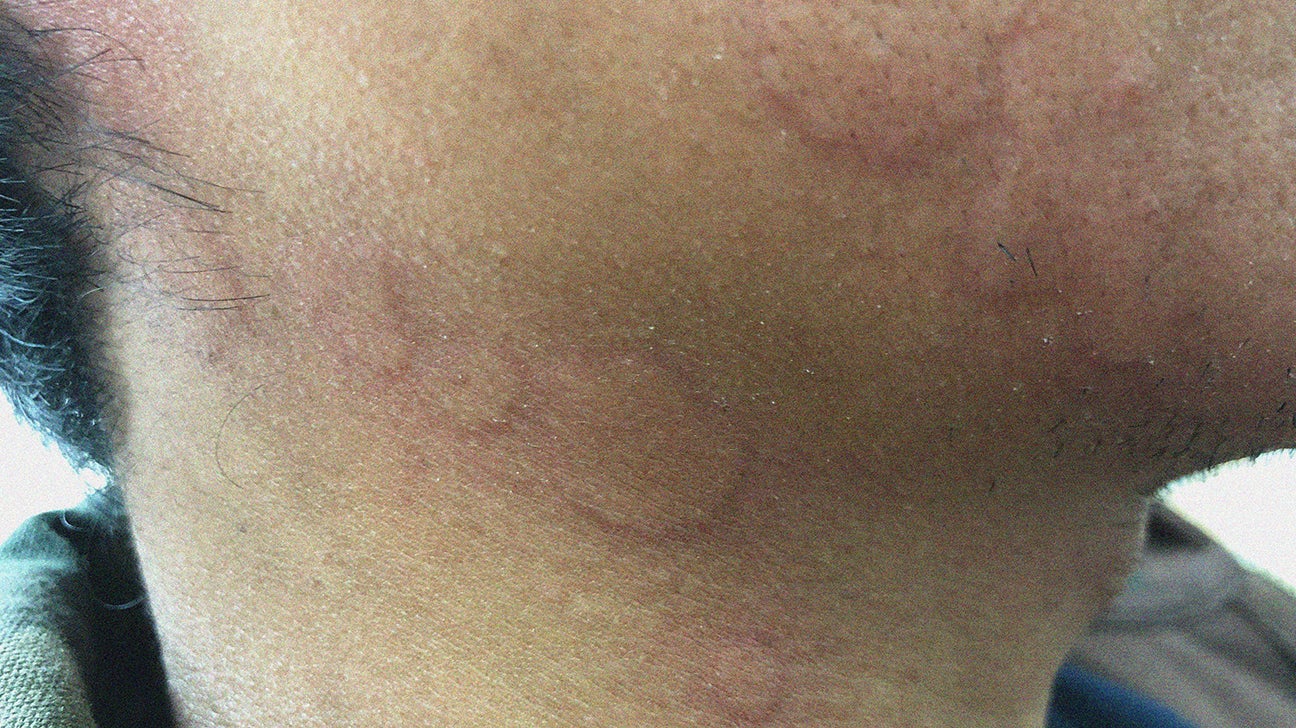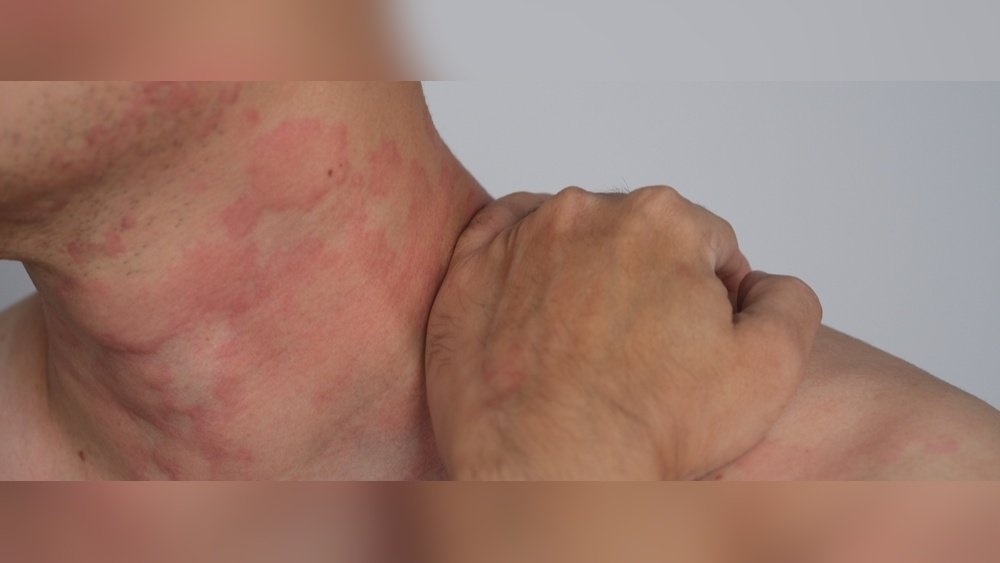Have you ever noticed an irritating rash appearing on your face right after you start sweating? It’s uncomfortable, itchy, and often leaves you wondering why your skin reacts this way.
If this sounds familiar, you’re not alone—and understanding what triggers this rash is the first step to finding relief. Whether you’re working out, out in the Texas heat, or just dealing with everyday sweat, your face can react in surprising ways.
You’ll discover the common causes behind that pesky rash, what your skin is trying to tell you, and simple steps you can take to soothe and prevent it. Keep reading to reclaim your clear, comfortable skin even when you sweat.

Credit: www.autoimmuneinstitute.org
Heat Rash Causes
Heat rash happens when sweat gets trapped under the skin. This usually occurs because sweat ducts become blocked. The trapped sweat causes redness, bumps, and itching on the skin. The face is a common area to get this rash, especially during hot weather or after exercise.
Understanding what causes heat rash helps prevent and treat it effectively. Two main causes are heat rash (miliaria) and cholinergic urticaria. Both affect the skin when sweating but have different triggers and symptoms.
Heat Rash (miliaria) Causes
Heat rash occurs when sweat ducts get clogged. Sweat builds up under the skin instead of reaching the surface. This blockage causes irritation and red bumps. Wearing tight or heavy clothing can worsen the blockage. Hot, humid weather increases sweat production and risk of rash.
Cholinergic Urticaria Causes
This rash happens when the nervous system releases acetylcholine during sweating. Acetylcholine irritates the skin and triggers an allergic reaction. This reaction causes red, itchy hives and raised bumps. It often appears after exercise or stress that makes you sweat.
Cholinergic Urticaria Triggers
Cholinergic urticaria triggers are specific factors that cause this rash to appear. This condition happens when the body reacts to a rise in core temperature. The nervous system releases acetylcholine, which irritates the skin. This leads to red, itchy bumps and swelling. Understanding these triggers helps manage and reduce flare-ups.
Physical Exercise
Exercise raises body heat quickly. This causes sweating and releases acetylcholine. Many people with cholinergic urticaria get rashes during or after workouts. Even light activities can trigger symptoms in sensitive individuals.
Hot Showers And Baths
Hot water increases skin temperature. It makes sweat glands work harder. This can set off the rash in some people. Taking cooler showers often helps reduce symptoms.
Stress And Anxiety
Stress affects the nervous system. It can cause the body to release more acetylcholine. This may trigger the rash without physical sweating. Relaxation techniques might lower the chance of outbreaks.
Warm Weather And Humidity
High temperatures and humidity make sweating easier. These conditions often cause flare-ups. Staying in cooler places and using fans can help keep the skin calm.
Spicy Foods
Eating spicy food can raise body temperature. This leads to sweating and acetylcholine release. People with cholinergic urticaria may notice rashes after spicy meals. Avoiding such foods can reduce symptoms.
Symptoms To Watch For
Recognizing the symptoms of a trigger rash on the face when sweating helps in early care. These signs show how your skin reacts to heat and sweat. Knowing them can prevent discomfort and worsening.
Red And Itchy Bumps
Small red bumps often appear on the face after sweating. These bumps may itch and cause mild irritation. The skin feels uncomfortable and sensitive to touch.
Fluid-filled Blisters
Some rashes develop tiny blisters filled with clear fluid. These blisters can burst and cause more irritation. They usually appear in clusters on affected areas.
Mild Swelling And Redness
The skin may swell slightly around the rash. Redness often spreads beyond the bumps. This shows inflammation caused by trapped sweat or skin reaction.
Prickly Or Stinging Sensation
A burning or prickly feeling can occur with the rash. This sensation makes the skin feel hot and uncomfortable. It often worsens with continued sweating.
Raised Hives And General Itching
Raised, red hives sometimes form with a rash from sweating. These hives look like swollen bumps and itch strongly. The rash may spread quickly over the face.

Credit: www.medicalnewstoday.com
Prevention Strategies
Preventing a rash on the face caused by sweating requires simple yet effective habits. These strategies help keep the skin cool, dry, and free from irritation. They focus on reducing sweat buildup and avoiding triggers that block sweat ducts or cause allergic reactions.
Practicing these prevention tips can reduce discomfort and keep your skin healthy during hot or active days.
Stay Cool And Dry
Keep your environment cool to prevent excessive sweating. Use fans or air conditioning indoors. Avoid direct sunlight and hot, humid places. After sweating, gently pat your face dry with a soft towel. Do not rub, as it may irritate the skin. Wearing a wide-brimmed hat outdoors can also help shield your face from heat.
Choose Breathable Clothing
Wear loose, lightweight clothes made from natural fabrics like cotton. These materials allow air to flow and absorb sweat. Avoid tight or synthetic clothing that traps heat and moisture. A breathable shirt collar or bandana can help absorb sweat near the face. Change clothes if they become wet or damp from sweat.
Use Gentle Skincare Products
Select skincare products that are free of heavy oils or fragrances. These can clog sweat ducts and worsen rashes. Use mild, non-comedogenic cleansers and moisturizers. Wash your face with cool water after sweating. Avoid harsh scrubs or exfoliants that may harm sensitive skin. Applying a lightweight, soothing lotion can calm irritation.
Manage Physical Activity
Limit intense exercise during hot and humid weather. Opt for early morning or late evening workouts when it is cooler. Take frequent breaks to cool down and wipe sweat away gently. Hydrate well to help regulate body temperature. If sweating triggers rashes, try lighter activities like walking or stretching.
Relief And Care Tips
Managing trigger rash on the face caused by sweating demands gentle and consistent care. The right steps can reduce irritation and speed healing. Focus on cooling the skin and preventing further sweat buildup. Clean skin and breathable fabrics also help maintain comfort. These simple actions improve skin health and reduce rash symptoms effectively.
Cooling The Skin
Move to a cooler place to stop sweating. Use a cold compress on the rash area. This reduces heat and itching. Avoid hot water or harsh scrubs that can worsen irritation. Cool showers help lower body temperature and clean sweat away.
Keeping Skin Clean
Wash your face gently with mild soap and cool water. Avoid heavy creams or oily products that block pores. Pat the skin dry with a soft towel. Clean skin prevents bacteria buildup and reduces rash severity.
Wearing Loose, Breathable Clothing
Choose clothes made from natural fibers like cotton. Loose clothing allows air to circulate and keeps skin dry. Avoid tight fabrics that trap sweat and heat. Proper clothing reduces sweat buildup and skin irritation.
Using Gentle Skincare Products
Pick fragrance-free and non-comedogenic skincare items. These products do not clog pores or irritate sensitive skin. Avoid strong chemicals or exfoliants until the rash clears. Gentle care supports skin healing and comfort.
When To See A Doctor
Seek medical advice if the rash lasts more than a few days. Watch for signs of infection like pus or swelling. A doctor can recommend creams or treatments to reduce symptoms. Early care prevents complications and promotes faster recovery.

Credit: chicnutrix.com
When To Seek Medical Help
Knowing when to seek medical help for a rash triggered by sweating is important. Most rashes clear up with simple care. Some cases need professional advice to prevent complications.
Watch for signs that the rash is getting worse or not healing. Early treatment can stop infections and ease discomfort.
Persistent Or Worsening Rash
If the rash stays for more than a week or grows worse, see a doctor. Continuous redness, swelling, or pain may signal a deeper problem.
Signs Of Infection
Look for pus, yellow crusts, or warmth around the rash. These signs suggest infection and need medical treatment. Antibiotics or antifungal medicines might be required.
Severe Itching Or Discomfort
Intense itching or pain that stops daily activities needs a medical check. A doctor can offer stronger treatments to relieve symptoms.
Rash With Other Symptoms
Rashes with fever, difficulty breathing, or swelling of the face need urgent care. These could be signs of a serious allergic reaction or illness.
Frequently Asked Questions
Why Does My Face Get A Rash When I Sweat?
Sweating can cause rashes due to blocked sweat ducts trapping sweat, leading to heat rash. Nerve chemicals may trigger itchy hives, irritating skin.
What Would A Sweat Rash Look Like?
A sweat rash appears as red, itchy bumps or small blisters. It may cause mild swelling and a prickly sensation on the skin.
How To Stop Getting A Sweat Rash?
Stay cool and dry by wearing loose, breathable cotton clothes. Shower with cool water after sweating. Avoid heavy skin products that block pores. Keep skin clean and in ventilated areas to prevent sweat rash.
How To Treat Skin Allergy Due To Sweat?
Treat sweat-related skin allergy by cooling the skin with cold compresses. Take cool showers to remove sweat. Wear loose, breathable cotton clothing. Avoid heavy, oily skincare products. Seek medical help if rash persists or shows infection signs.
Conclusion
Sweat can cause rashes by trapping moisture under the skin. Blocked sweat ducts often lead to red, itchy bumps. Cooling down and wearing loose, breathable clothes helps prevent flare-ups. Keeping your skin clean with cool showers reduces irritation. Persistent rashes may need a doctor’s advice.
Managing sweat and skin care lowers discomfort and improves skin health. Taking simple steps can keep your face rash-free during sweating. Stay aware of your body’s signals to protect your skin.
 Skip to content
Skip to content 